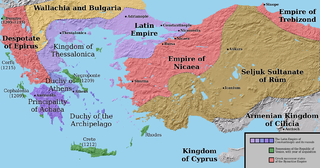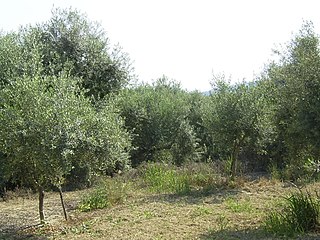Related Research Articles

The Principality of Achaea or Principality of Morea was one of the three vassal states of the Latin Empire, which replaced the Byzantine Empire after the capture of Constantinople during the Fourth Crusade. It became a vassal of the Kingdom of Thessalonica, along with the Duchy of Athens, until Thessalonica was captured by Theodore, the despot of Epirus, in 1224. After this, Achaea became for a while the dominant power in Greece.

William of Villehardouin was the fourth prince of Achaea in Frankish Greece, from 1246 to 1278. The younger son of Prince Geoffrey I, he held the Barony of Kalamata in fief during the reign of his elder brother Geoffrey II. William ruled Achaea as regent for his brother during Geoffrey's military campaigns against the Greeks of Nicaea, who were the principal enemies of his overlord, the Latin Emperor of Constantinople Baldwin II. William succeeded his childless brother in the summer of 1246. Conflicts between Nicaea and Epirus enabled him to complete the conquest of the Morea in about three years. He captured Monemvasia and built three new fortresses, forcing two previously autonomous tribes, the Tzakones and Melingoi, into submission. He participated in the unsuccessful Egyptian crusade of Louis IX of France, who rewarded him with the right to issue currency in the style of French royal coins.

The Battle of the Olive Grove of Kountouras took place in the summer of 1205, in Messenia in the Morea peninsula, between the Frankish Crusaders and the local Byzantine Greeks, resulting in a victory of the Franks and the collapse of the local resistance.
Villehardouin was a noble dynasty that originated in Villehardouin, a former commune of the Aube department, now part of Val-d'Auzon, France. It is most notable as the ruling house of the Principality of Achaea, a Frankish crusader state in the Peloponnese peninsula of Greece, between 1209 and 1278, when possession passed to the Angevin Kings of Naples.

Florent of Hainaut was Prince of Achaea from 1289 to his death, in right of his wife, Isabella of Villehardouin. He was the son of John I of Avesnes and Adelaide of Holland. From his father he received the stadholdership (government) of Zeeland.
John Chauderon was the Baron of Estamira and Grand Constable of the Principality of Achaea, the strongest of the principalities of Frankish Greece.

The Barony of Akova was a medieval Frankish fiefdom of the Principality of Achaea, located in the mountains of eastern Elis in the Peloponnese peninsula in Greece, centred on the fortress of Akova or Mattegrifon. It was among the twelve original baronies of Achaea, but was conquered by the Byzantines in 1320.

The Barony of Nikli was a medieval Frankish fiefdom of the Principality of Achaea, located in the southern Arcadia region of the Peloponnese peninsula in Greece, and centred on the town of Nikli, also known as Amyklai or Amyklion.

The Barony of Arcadia was a medieval Frankish fiefdom of the Principality of Achaea, located on the western coast of the Peloponnese peninsula in Greece, and centred on the town of Arcadia, ancient and modern Kyparissia.
Vilain of Aulnay was a French knight from Aulnay-l'Aître in the Champagne who became marshal of the Latin Empire of Constantinople and first Baron of Arcadia in the Principality of Achaea. In the Greek version of the Chronicle of the Morea, he is attested as Βηλὲς ντὲ Ἀνόε, a form which passed to the other versions of the Chronicle as Anoé, Annoée or Anoée.
Geoffrey of Briel, in older literature Geoffrey of Bruyères, was a French knight and the third lord of the Barony of Karytaina in the Principality of Achaea, in Frankish Greece. He led a colourful and turbulent life, narrated in detail in the Chronicle of the Morea. Accounted the finest knight in the Principality, he fought in the wars against the Byzantine Greeks, was captured in the Battle of Pelagonia in 1259, and was sent back to Achaea bearing the Byzantine terms in 1261. Geoffrey was twice deprived of his barony, once for rebelling against his uncle, the Prince of Achaea William II of Villehardouin, and then for abandoning the Principality without leave in order to spend time with a mistress, the wife of one of his feudatories, in Italy. He was pardoned both times, but henceforth held his title as a gift of the Prince. He died childless in 1275, and the Barony of Karytaina was split up.
Andronikos Asen Zaccaria de Damala or Asanes was a Genoese lord of the Principality of Achaea in southern Greece.
Anna Komnene Doukaina, known in French as Agnes, was princess-consort of the Principality of Achaea in 1258–1278 and regent between 1259–1262, during the captivity of her husband, Prince William II of Villehardouin, by the Byzantine emperor Michael VIII Palaiologos. After William II's death in 1278, she re-married to the powerful baron Nicholas II of Saint Omer.
Nicholas le Maure was a French knight of the Principality of Achaea, lord of Saint-Sauveur, who served as the Principality's bailli on behalf of the Angevins of Naples between 1314 and 1315/6.
Peter dalle Carceri was a Triarch of Euboea and Baron of Arcadia. He was descended from the noble Dalle Carceri family, son of Grapozzo dalle Carceri and Beatrice of Verona, both Lords of Euboea.
Geoffrey II of Briel or Geoffrey of Briel the Younger, was a French knight and the cousin or nephew of Geoffrey I of Briel, Baron of Karytaina in the Principality of Achaea, in Frankish Greece.

The Battle of Saint George took place on 9 September 1320 between the Latin Principality of Achaea and the forces of the Byzantine governor of Mystras, at the fortress of Saint George in Skorta in Arcadia. As a result of the battle, Arcadia, the heartland of the Morea, came firmly under Byzantine control.
Erard III Le Maure was Baron of Arcadia and Marshal of the Principality of Achaea in the mid-14th century.
Erard I of Aulnay was lord of one half of the Barony of Arcadia in the Principality of Achaea.
Vilain II of Aulnay was Baron of Arcadia in the Principality of Achaea in the early 14th century.




